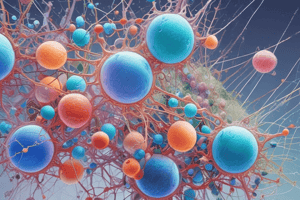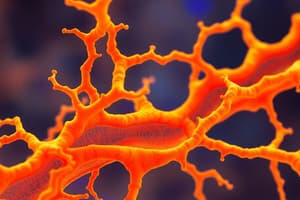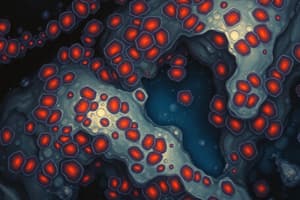Podcast
Questions and Answers
What is one function of the primary cell wall?
What is one function of the primary cell wall?
- Mediates adhesion between organelles
- Allows for cell expansion (correct)
- Enhances tissue waterproofing
- Provides insulation to tissues
What role does lignin play in plant tissues?
What role does lignin play in plant tissues?
- Enhances rigidity and waterproofing (correct)
- Inhibits cell division
- Induces cell migration
- Provides compression resistance
Which of the following statements about plasmodesmata is true?
Which of the following statements about plasmodesmata is true?
- They are responsible for cell-to-cell adhesion.
- They are found exclusively in animal cells.
- They are integral to the Supracellularity Hypothesis. (correct)
- They allow movement of large proteins only.
What is a characteristic of secondary cell walls?
What is a characteristic of secondary cell walls?
How do cell walls contribute to tissue and organ specialization?
How do cell walls contribute to tissue and organ specialization?
What is the primary component of pectin in cell walls?
What is the primary component of pectin in cell walls?
What function does the cell wall serve regarding signaling molecules?
What function does the cell wall serve regarding signaling molecules?
What process is affected by integrin switching during cell migration?
What process is affected by integrin switching during cell migration?
What is the role of Na+-driven glucose symport in glucose transport?
What is the role of Na+-driven glucose symport in glucose transport?
How do tight junctions contribute to epithelial function?
How do tight junctions contribute to epithelial function?
What occurs at the basolateral domain during glucose transport?
What occurs at the basolateral domain during glucose transport?
What is a key requirement for the Na+-glucose symport during glucose transport?
What is a key requirement for the Na+-glucose symport during glucose transport?
Which epithelial structures are primarily influenced by tight junctions?
Which epithelial structures are primarily influenced by tight junctions?
What is the primary function of occluding junctions?
What is the primary function of occluding junctions?
Which type of junction is classified as a communicating junction?
Which type of junction is classified as a communicating junction?
Which protein is crucial for stability and barrier function in tight junctions?
Which protein is crucial for stability and barrier function in tight junctions?
Which of the following proteins determines the barrier properties of the cell contacts in tight junctions?
Which of the following proteins determines the barrier properties of the cell contacts in tight junctions?
Which junction type encircles the apical end of each cell in epithelial sheets?
Which junction type encircles the apical end of each cell in epithelial sheets?
What is the primary role of cadherins in animal cells?
What is the primary role of cadherins in animal cells?
Which protein serves as scaffolding in the assembly of tight junctions?
Which protein serves as scaffolding in the assembly of tight junctions?
What type of junction is characterized by an anastomosing network of protein strands?
What type of junction is characterized by an anastomosing network of protein strands?
Which type of intercellular junction is specifically designed for attachment to intermediate filaments?
Which type of intercellular junction is specifically designed for attachment to intermediate filaments?
Which of the following is a role of cingulin in intercellular junctions?
Which of the following is a role of cingulin in intercellular junctions?
What is the primary role of linker molecules in the ECM?
What is the primary role of linker molecules in the ECM?
Which mechanism allows ECM proteins to accumulate adjacent to target tissues?
Which mechanism allows ECM proteins to accumulate adjacent to target tissues?
What structural feature is common to fibronectin?
What structural feature is common to fibronectin?
How do ECM components change as development progresses?
How do ECM components change as development progresses?
What is the primary function of cellulose in plant cells?
What is the primary function of cellulose in plant cells?
Which protein is known to link microfibrils together in the extracellular matrix?
Which protein is known to link microfibrils together in the extracellular matrix?
What does encapsulation of ECM components refer to?
What does encapsulation of ECM components refer to?
Which statement best describes hemicellulose?
Which statement best describes hemicellulose?
What characteristic distinguishes the cell walls of different organisms?
What characteristic distinguishes the cell walls of different organisms?
What role does signaling play in cell differentiation with respect to ECM interaction?
What role does signaling play in cell differentiation with respect to ECM interaction?
What is the primary arrangement of septate junctions in epithelial cells?
What is the primary arrangement of septate junctions in epithelial cells?
Which statement about connexons is true?
Which statement about connexons is true?
How do gap junctions primarily function between cells?
How do gap junctions primarily function between cells?
What factors can cause gap junctions to close?
What factors can cause gap junctions to close?
What characteristic is common to most connexin disorders?
What characteristic is common to most connexin disorders?
Flashcards are hidden until you start studying
Study Notes
Linker Molecules
- Connect collagen and proteoglycans in the extracellular matrix (ECM) and with the plasma membrane via fibronectin and laminin, which are adhesive glycoproteins.
- Contain multiple domains that serve as binding sites for other ECM components and cell surface receptors.
- Accumulate in target tissues through local synthesis, migration of cells, or distant secretion followed by capture.
Fibronectin
- Composed of two nearly identical polypeptide chains linked by disulfide bonds.
- Functions in ECM assembly at specific sites within the developing organism.
- Accumulation can occur via receptor-dependent or independent mechanisms, requiring interaction with proteins on target tissues.
ECM and Development
- ECM composition evolves throughout the development of an organism.
- Certain ECM components are localized to specific developing tissues.
- Interaction with the ECM is crucial for signaling pathways that promote cell differentiation.
ECM of Plant Cells
- Contains cell wall (CW) components such as microfibrils of cellulose embedded in polysaccharide and protein matrices.
- Functions of the CW include providing rigidity, serving as a permeability barrier and protecting cells from damage and infection.
Cell Wall Components
- Cellulose: A glucose-based polysaccharide contributing tensile strength.
- Hemocellulose & Extensins: Link microfibrils into a network, facilitating cell expansion and structure.
- Pectin: Polysaccharide that aids in adhesion and forms matrix structures for support.
- Lignin: Complex polymer present in woody tissues offering enhanced rigidity and waterproofing.
Cell Wall Structure
- Primary CW: Thin wall formed during cell division, allowing expansion.
- Secondary CW: Thicker and more rigid, formed post-growth, often with high cellulose content and potential lignin.
- Plasmodesmata serve as cytoplasmic bridges connecting adjacent plant cells, allowing transport of solutes and regulatory molecules.
Cell Junctions
- Occluding Junctions: Seal epithelial cells, preventing leakage of water-soluble molecules.
- Tight Junctions: Present in vertebrates, contribute to barrier function and segmentation of membrane domains.
- Septate Junctions: Found in invertebrates, form continuous bands around epithelial cells.
Proteins Involved in Tight Junctions
- Occludin: Crucial for junction stability and barrier integrity.
- Claudin: Determines barrier characteristics between cells.
- ZO Proteins: Scaffolding proteins that aid in the structural organization of junctions.
- Cadherins: Mediate cell adhesion and are essential for tissue morphogenesis and stability.
Functions of Junctions
- Tight junctions prevent free passage of solutes, creating barriers in tissues like the intestinal epithelium.
- Localize and constrain transport proteins to their respective membrane domains, ensuring proper function and signaling within cells.
Studying That Suits You
Use AI to generate personalized quizzes and flashcards to suit your learning preferences.




